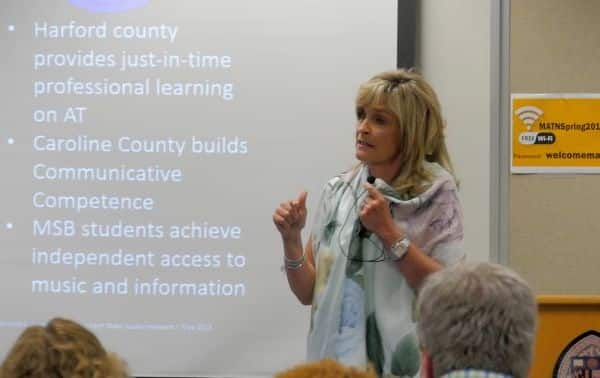Franczkowski Emphasizes Importance of Integrating Assistive Technology

“For most of us, technology makes things easier. For a person with a disability, it makes things possible.” – Judy Heumann, former Assistant Secretary of the Office of Special Education Programs (OSEP).
Assistive technology should be part of a thoughtful, integrated, data-informed approach to support students across educational environments and not seen as a stand-alone service delivered by one specialist.
This was the message that Marcella E. Franczkowski, Assistant State Superintendent for the Maryland State Department of Education Division of Special Education, had for the leaders in the assistive technology field at the 2018 MATN Spring Institute at Johns Hopkins University’s Center for Technology in Education.
Franczkowski emphasized the importance of integrating assistive technology into specially designed instruction with the intention of building independence over time so students can fully participate in instruction and activities and leave school college-, career-, and community-ready. Independence is best achieved when the school community, students, and families collaborate in the best interest of the student.
Taking this approach from early childhood will support students throughout their education, maximizing their access to instruction and their ability to succeed, she said. Implementing specially designed instruction, including assistive technology when appropriate, in an integrated tiered system of supports serves as a “steroid” for students with disabilities.
“We can narrow the gap more effectively and more efficiently the earlier we begin our dosage, the intensity of our dosage, the intervention of our work, and through assistive technology,” Franczkowski said. “It is assistive technology in early education that opens up communication.”
Ensuring that students receive appropriate benefits from assistive technology requires the collaborative efforts of special and general education teachers, AT specialists, other service providers, and families. The assistive technology must be implemented across environments and activities throughout the school day as needed to promote the student’s engagement and access.
The integration and implementation of assistive technology is part of the state’s broader vision to create opportunity and access for all students, and to prepare them for college, careers, and community readiness beginning in early childhood through the use of strategic collaborations, evidence-based practices, data-informed decisions, professional learning, and family partnerships.

